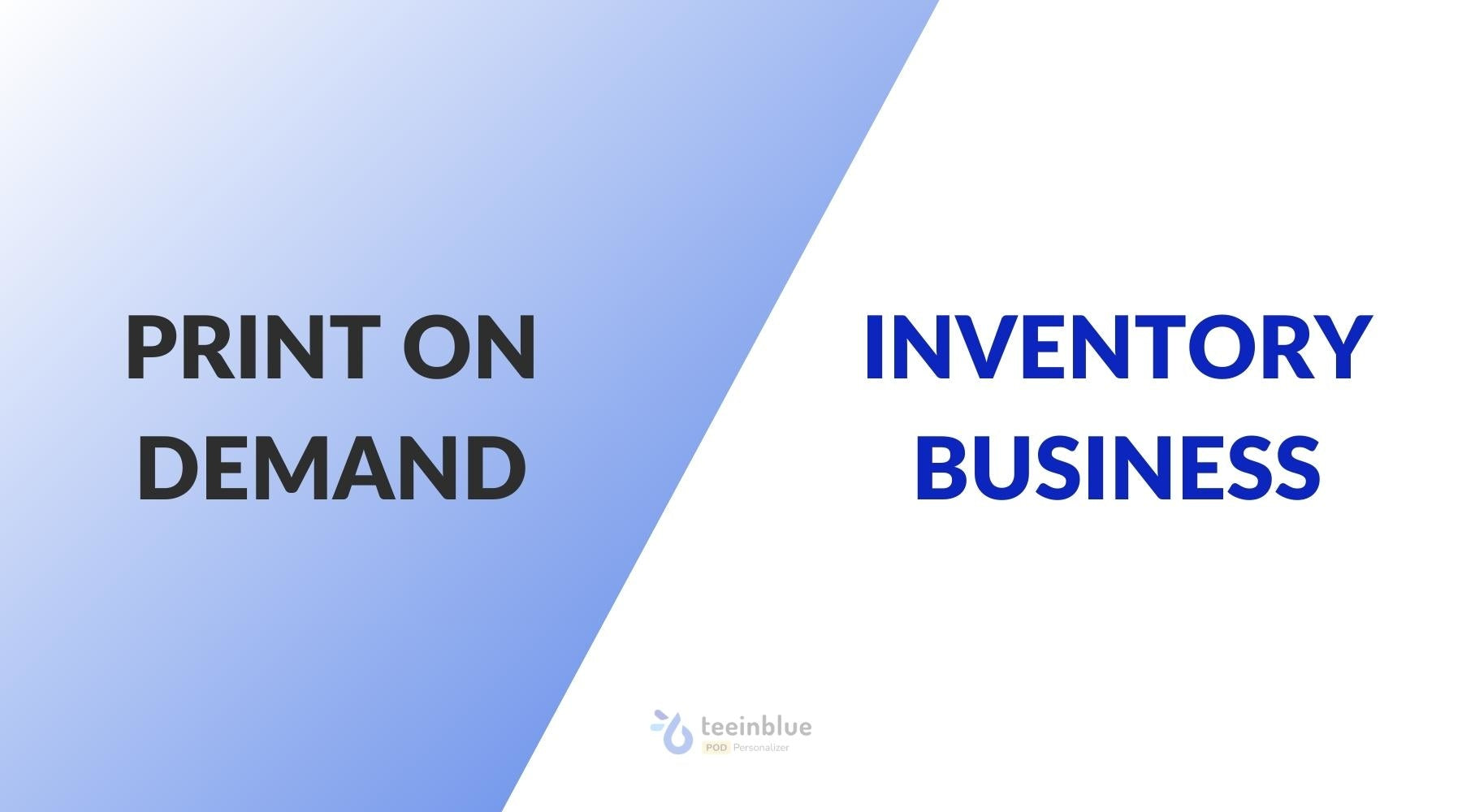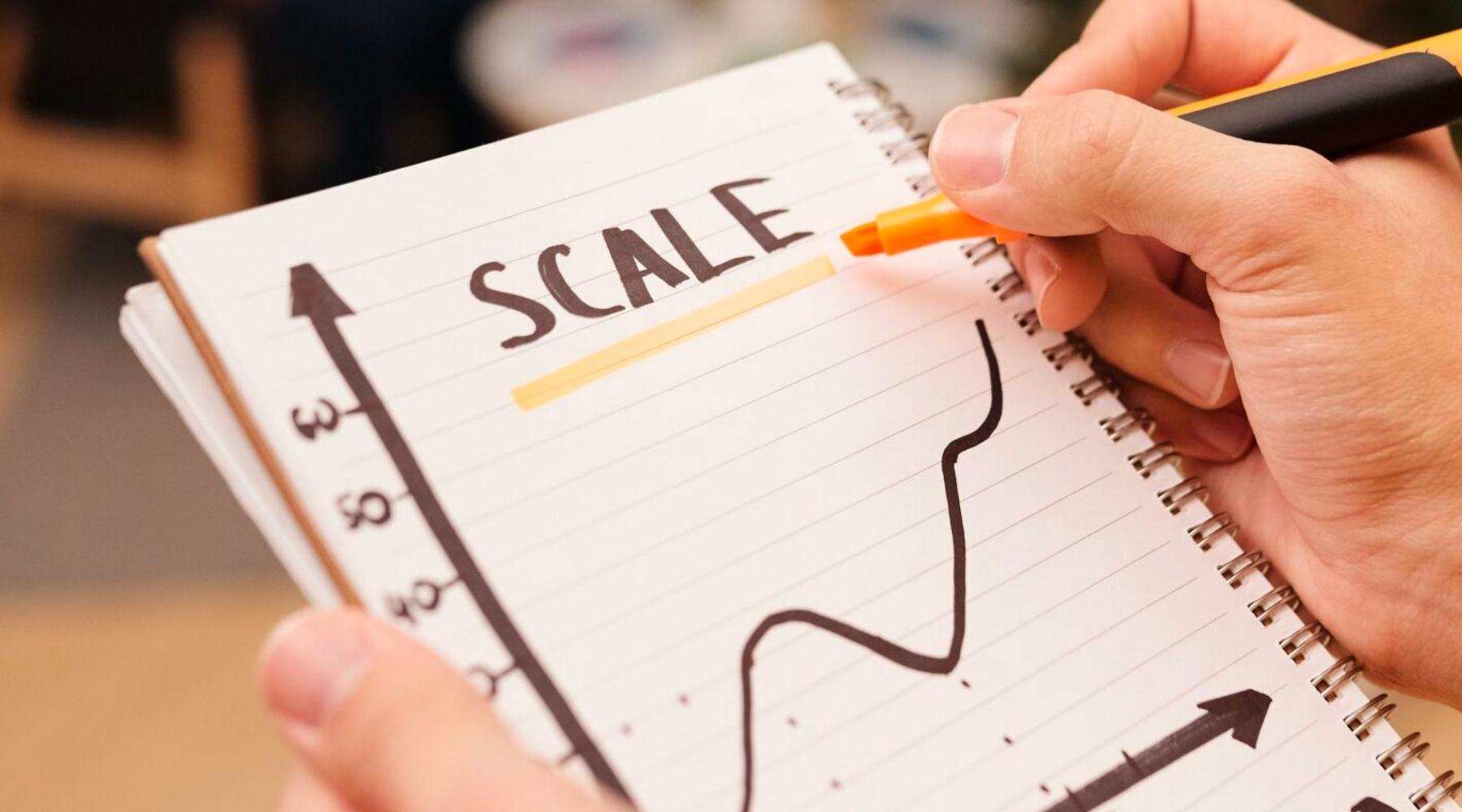Print-on-demand Vs Inventory: Which is Better to Start?
-
Table of contents

Let’s dive into this article with Teeinblue to explore the differences between print-on-demand vs inventory. Covering aspects from the definition, process, cost, production control, time efficiency, and scalability, to profit margin. Get ready to broaden your mindset and choose the most suitable model for your business. Wrap it up now!
Print-on-demand Vs Inventory Business: 7 Core Differences
Print-on-demand differs from inventory in 7 key points: definition, process, cost, production control, time spent, scalability, and profit margin. Check the one-by-one distinction here!
Definition
Print-on-demand involves creating artwork and operating an online store to reach customers. In contrast, the inventory model entails the whole process, from pre-purchase and storage to distribution of goods.
Print-on-demand means that you work with third-party companies to print and sell white-label products under your brand. These suppliers manage production, packing, and logistics. Without having any stock, you only focus on creating unique designs and marketing them to your targeted audience.
Running an inventory business means buying items, goods, and materials at low prices. Then you store them in the warehouse or even produce them and sell them at higher prices. With inventory, you handle various aspects of the business, similar to print-on-demand suppliers.
For example, when you sell POD t-shirts, you are not responsible for the factory, inventory, and delivery. On the other hand, an inventory business model requires you to bulk purchase pre-made t-shirts, package, and ship orders. You also have to manage stock meticulously to ensure ready stock for selling.

Process
The print-on-demand approach simplifies the process of business by eliminating hassle steps like fulfillment and shipping. Conversely, managing inventory demands a broader skill set and involves more intricate aspects.
As a print-on-demand seller, you need to set up an online store and craft captivating designs for specific niches. When orders come, you send them to suppliers for fulfillment and delivery.
For the inventory model, you repeat the process of importing goods, organizing stock, and predicting which products to sell. You’re also responsible for order placement by parceling, and shipping to the customer’s address.
Imagine you run a t-shirt print-on-demand store, everything you need is a well-built online store and collection of eye-catching artwork. However, the workload of a t-shirt inventory business tends more complex. You are involved in negotiating cost-effective prices with suppliers, tracking stock quantity to ensure availability, and more.

Cost
It’s obvious that print-on-demand is significantly cheaper with lower risks to start than the inventory.
Here's a detailed breakdown of the cost between these two business models.
Print-on-demand, without the need for inventory, machinery, and warehouse, incurs minimal upfront costs. Your startup costs comprise product design fees, POD platform fees, and customization fees for an online store on Shopify, Etsy, etc. Once your store runs, some costs come into play like platform monthly charge, marketing costs, customer service expenses, etc.
The inventory demands a substantial initial investment, including purchase, logistics, and holding costs. Overhead expenses to consider encompass shortage, inventory management, marketing, and employee costs.
For instance, to sell print-on-demand t-shirts on Shopify, you initially pay a subscription fee starting from $25 per month. Additional expenses may arise in the operation, covering transaction fees, advertising costs, app extension fees, etc. With inventory, besides online store management fees, you have to invest significantly in purchasing t-shirts in bulk, renting a warehouse, and covering packaging costs.

Production Control
While print-on-demand sellers heavily rely on the trustworthiness of their suppliers, inventory owners have more control over the quality of their products.
Due to the inherent nature of print-on-demand, there is no ability to step into the manufacturing process. You depend solely on their suppliers for product quality. Make sure to order samples for quality testing and carefully select reliable suppliers.
In contrast, the inventory model allows you to physically assess the material or color of products. Therefore, you can rectify any issues before delivering, ensuring that your customers can get high-quality items.
Running a t-shirt business in an inventory way, you have the hands-on ability to directly touch and feel the t-shirt. You can check if the material is comfortable or the color is vibrant. Therefore, you can make sure your buyers won’t receive subpar t-shirts and enhance their purchase experience. This is something a print-on-demand seller cannot do.

Time Spent
Unlike the inventory model which requires more time and effort, print-on-demand enables you to dedicate just a few hours per day to your online store.
By leaving tiresome stages such as printing, packing, and shipping to POD suppliers, you free up more time. This flexibility helps you earn print-on-demand passive income or utilize your time to develop new ideas, refine marketing strategies, or enhance customer services.
Conversely, inventory entails time-consuming tasks such as tracking stock levels, managing storage, and wrapping and shipping. However, this approach gives you the ability to optimize customer experience. This includes ensuring the quality of the product, meticulous packaging, and timely delivery.
A print-on-demand t-shirt store may become your passive income dedicating just 2-3 hours a day. However, inventory demands a commitment of time and effort as you carry all aspects of the business.

Scalability
When expanding a business, print-on-demand proves easier and more cost-effective than the inventory approach.
With no worries about excess inventory, the print-on-demand model is particularly suitable for testing products of various types. To achieve success in scaling, you should focus on crafting unique designs and updating growing demand and market trends.
Though having available stock is a key advantage, inventory has a constraint on the money needed to expand. While investing in accurate demand forecasting, you must ensure sufficient capital to avoid financial problems.
Suppose that you own a t-shirt print-on-demand store specializing in the pet niche. You can effortlessly create various dog breed designs to test the market's demand within the cost of design and marketing. There are no more worries about a high risk of obsolete stock like the inventory model.

Profit Margin
In general, inventory often yields higher profit margins than print-on-demand due to lower production cost and bulk-scale purchasing.
Print-on-demand typically operates with a lower profit margin, often in the range of 15%-20%. This is due to the higher production cost per item, especially when considering the product customization inherent to print-on-demand.
Large-scale production in inventory models leads to a decrease in per-unit production costs. With the stock in hand, you can strategically adjust prices to maximize profit by capitalizing on market demand.
If you notice a growing demand for Christmas-related t-shirts, having ready-to-sell shirts is a significant advantage. The ability to promptly ship products to buyers without the need for printing allows you to capitalize on the trend quickly. You can raise your prices higher to tap into the trend and boost profits.
A SUM-UP
The summary table below outlines the pros and cons of print-on-demand and inventory to help you gain a clear understanding. Here you go!
| Model | Advantages | Disadvantages |
| Print-on-demand |
|
|
| Inventory |
|
|
💡 You may also like: Pros and Cons of Print-on-demand: An In-depth Analysis
Print-on-demand or Inventory: How to Choose?
A well-matched model plays a vital role in elevating your business to new heights of success. Scroll down to explore how to figure out the right fit for your needs.
Define Business Goals
It’s crucial to clarify your specific business goals, requirements, and financial capacity before diving into work. A deep understanding of your market, customers, and products helps you build a strategic plan.
For instance, print-on-demand offers greater flexibility in product variety and customization. This model works best to test new products or market demand. On the other hand, inventory is better for businesses with consistent product lines.
Consider Financial Capability
According to Investopedia, financing constraints are the leading causes of small business failures. To safeguard your venture, evaluate your available resources before selecting print-on-demand or inventory.
Print-on-demand is suitable for those on a tight budget without significant upfront costs or overhead expenses. In case you have ample funds and are open to taking risks, the inventory approach yields greater profitability.

Evaluate Skills & Strengths
Print-on-demand and inventory require different skill sets to complete their respective scopes of work. Self-awareness about your strengths and acquired skills helps avoid a mismatch between your skills and the demands of the chosen role.
A print-on-demand seller needs simple design skills and a creative mindset to create artwork for selling. However, managing inventory demands a more extensive skill set, including supply chain management, inventory control, cost analysis, and more.
FAQs on POD vs Inventory
Let's address some frequently asked questions about print-on-demand and inventory models.
What Are the Key Differences Between Print-on-demand and Inventory?
Major differences between the two models include definition, process, expense, quality, time spent, growth potential, and profitability. Particularly, print-on-demand stands out for its streamlined process and lower initial costs compared with inventory.

Can Print-on-demand Offer the Same Quality as Inventory Businesses?
The quality of print-on-demand products heavily depends on the chosen companies. Some reliable partners can provide comparable or even superior quality than inventory-based models. It's crucial to ensure that you carefully select trustworthy partners to maintain the desired quality standards in your business.
How to Achieve Above-Average Profits Using Print-on-demand?
Selling personalized products allows you to easily capture customers' attention with personal touches. Buyers tend to spend more on tailor-made items, helping you generate increased profits.
It’s best to build a Shopify store and install Teeinblue Product Personalizer to begin your lucrative print-on-demand journey. Hold in hand the easy-to-practice steps below.
- Establish a Shopify store.
- Connect with a POD company to integrate.
- Choose products and design artwork.
- Install Teeinblue Product Personalizer to add custom options for customers to choose from.
With an intuitive interface and diverse customizer features, Teeinblue Product Personalizer has become a top-rated app on Shopify. Let’s explore how it helps!
Hope this article provides you helpful comparison to enhance your understanding of two prevalent business models. You can now make an informed choice between print-on-demand vs inventory for starting your online business. Take time to join the Teeinblue Global Community for more helpful tips and insights about the print-on-demand market.
RELEVANT ARTICLES
Print-on-demand: What It Is, How It Works & Who It Is Best for
Pros and Cons of Print-on-demand: Uncover Lucrative Opportunities
How to Distinguish Print-on-demand vs Dropshipping?
Which is More Profitable: Print-on-demand vs Digital Products?
Print-on-demand Vs Do-it-yourself Core Differences for Beginners
Newsletters
Subscribe to get exclusive POD tips, trends, and insights!
Tags:
print on demand
